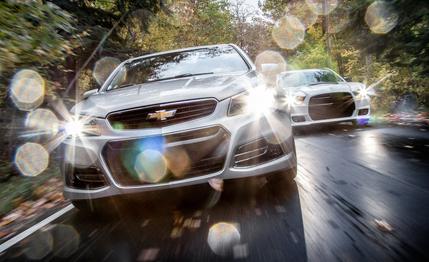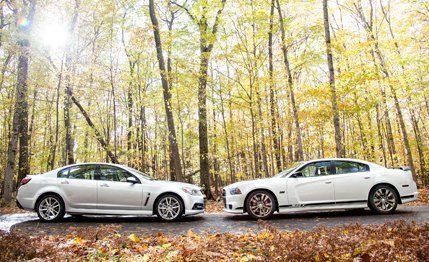
 Comparison Tests
Comparison Tests
Chevrolet laid its groundwork for the new SS with a profile body for the 2013 NASCAR circuit. The racing Chevy SS and the racing Dodge Charger would have each been that rarest of things: a V-8 rear-drive Sprint Cup competitor modeled after a V-8 rear-drive production car. But the SS arrived just as Dodge quit the series, so fans were cheated.
Instead, the speedway rivalry that never was has simply moved out to the parking lot. The production SS squares off here, on a rainy weekend, against the Dodge Charger SRT8. The latter has strutted alone in Detroit’s arena of civilian rear-wheel-drive muscle sedans since 2009, when GM pulled Pontiac’s plug and with it the SS’s excellent predecessor, the G8. While both the Charger and SS are more sensible than their two-door siblings, the Challenger and the Camaro, these old-school tire smokers cement their relevance by not really giving a damn about it.
Still, Chevrolet wants you to know that its new halo sedan is the brand’s first rear-drive four-door V-8 in nearly 20 years. The SS is as American as can be for a Euro-inspired car built in Elizabeth, South Australia, which is absolutely nowhere near Sydney or any place with a working telephone. Known as the Holden Commodore SS in its home market, the Chevy SS is GM’s third attempt to domesticate one of its Australian models—after the ill-fated Pontiac GTO coupe and G8 sedan.

 Thus equipped, the Dodge is up 55 horses, 55 pound-feet, and about 10 grand versus the Chevy. But it’s the SS that feels $10,000 dearer.
Thus equipped, the Dodge is up 55 horses, 55 pound-feet, and about 10 grand versus the Chevy. But it’s the SS that feels $10,000 dearer.
The Commodore’s current VF chassis (so named for the Aussie fashion of giving each new version of a model its own two-letter code) has been updated from the VE structure that we loved in the G8, but it’s still similar to what’s underneath the stubbier Chevrolet Camaro and the stretched Caprice PPV police cruiser. Additional aluminum in the suspension, subframes, hood, and trunklid helps the SS shed more than 100 pounds from a comparable G8. GM paid special attention to overall refinement and noise insulation, while a new electrical system supports all of the company’s latest safety and entertainment gear, including the feared switch to electric power steering.
A low-volume unicorn for the brand, the handful of SSs to be imported will all be pretty much fully equipped and ready to boogie for $45,770, including a $1300 gas-guzzler fee slapped on the sole engine—a 415-hp, 6.2-liter LS3 V-8. GM’s six-speed 6L80 automatic is sadly the only transmission offered. Although a power sunroof ($900) and a spare tire ($500) are optional, the sporty suspension, Brembo front brakes, and 19-inch wheels with performance tires are all standard.
The Charger SRT8 was last updated in 2012. It’s now a thoroughly modern muscle car, with a sinister mien, a 470-hp 6.4-liter Hemi V-8, driver-adjustable adaptive suspension, and even larger Brembo brakes all around. The Charger also is automatic-only, with just an old five-speed unit until ZF’s ubiquitous eight-speed enters service.
Although budget Super Bee versions of the 2014 SRT start at $45,380 (including $1000 in guzzler tax), the regular SRT is $3000 more and closer to 50 grand when equipped like the Chevrolet. Our test car was a 2013 model mechanically identical to the 2014 SRT; it blossomed from its $47,475 base price to $55,150 with the 2013-only 392 Edition appearance package ($2495), as well as a Harman/Kardon audio system ($1995) and Laguna leather seats ($1495), plus summer performance rubber and a few electronic watchdogs and gizmos that are standard on the SS.
As chest-thumping totems for their respective makes, these cars are here to claim bragging rights. So, after the obligatory burnouts, we headed for the last vestiges of fall color in rain-soaked northern Michigan to see which car best re-imagines the great American performance sedan.